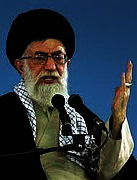Khamenei Launches a 10-Day Assault on the Green Movement
» On the Anniversary of Last Year’s Crackdown:
The website of Iran’s supreme leader ayatollah Ali Khamenei announced that for 10 days it would be publishing the leader’s remarks and directives on the post-election events in Iran under the title, “Thoughts and Lessons” as a way to commemorate the violent and bloody crackdown of post-election protestors that took place last year, which it proclaims as the victory over the seditionists, the term officials use to describe the Green Movement and pro-reform supporters. The occasion is known as the Dey 9 event in Iranian official parlance and fell on December 30th in 2010 (Dey is the tenth month of the Iranian calendar and the number 9 stands for the 9th day of that month).
Supporters of ayatollah Khamenei and Mahmoud Ahmadinejad proclaimed December 30, 2010 to be the response to the disrespectful actions and demonstrations that protesters engaged in on Ashura – the day Shiites commemorate the death of imam Hussein, the grandson of prophet Mohammad 1400 years ago in the town of Kerbala – in 2009. The government’s response to the anti-government demonstrations came in the form of a violent crackdown, which the government now calls “a victory” and celebrates. Demonstrations were held in Tehran and other Iranian cities on December 30, 2010 by government supporters.
In the course of street demonstrations by pro-reform supporters, known as the Green movement, on Ashura of 2009 - December 27, 2009 - government agents and official militia violently attacked and disrupted the demonstrations.
Security and judiciary officials of Iran, including ayatollah Khamenei himself, contend that on that day in 2009 protestors attacked mourners of the martyred imam and prayer givers, and therefore desanctified the Shiite’s third imam. Supporters of the Green Movement on the other hand have published abundant video clips and photographs on the Internet and satellite television stations to show that while they were peacefully mourning the death of the imam, security forces attacked them with lethal and non-lethal weapons.
Following that crackdown, the accepted leader of the Green movement Mir-Hossein Mousavi called the attack a “barbarian” act while labeling the victims of the attacks “God loving people,” who had poured into the street to attain their rightful rights.
Soon after the anti-government protests, ayatollah Khamenei called the demonstrations acts that ended the regime’s tolerance of the protestors. But during the annual celebrations in February when the Islamic republic celebrates is revolutionary victory over the monarchy that fell in 1979, he again said that the regime’s tolerance of the protestors had ended.
Till now, four chapters of the speeches by the ayatollah have been posted on the website for this project. The first chapter is titled, “Encouraging the Enemy,” the second, “Division within the Nation,” the third, “The Strange Goal of the Seditionists,” and the fourth, “are the actual speeches and lectures of the leader during his visit of the Basij militiamen in Qom,” in which the “principal goals of the enemy and elements of the soft war aimed at distorting reality” are explained.
Prior to this, Tehran’s temporary Friday prayer leader and a hardline supporter of the ruling establishment seyed Ahmad Khatami, who is also a member of the Experts Assembly on Leadership, had said that the reason for the supreme leader’s repeated exposes of the “seditionists” was because “the leaders of the sedition had not relented and retreated from their position during the last 18 months.”
As is usual in the Iranian perspective, ayatollah Khamenei’s website writes, “What is necessary in order to understand the issue is to see what goals is the enemy pursuing. One of these, which is among its soft war elements, is to distort reality and the events in the country, while presenting a pessimistic picture of the country, along with an image of its disintegration and at a state of dead end.”
In another part of the postings, the site claims that people rose against those it calls “seditionists” and on December 30, 2009 completely on their own and gave a hard slap to the protestors.
In yet another part of the site, the general message is that the leaders of the protestors made a big mistake in encouraging the enemy and giving them hope, which it calls “sinful.”
Sedition or Coup?
The two individuals who are generally associated with the “sedition”, i.e., the protests against the electoral fraud committed during the 2009 presidential election, are Mir-Hossein Mousavi and Mehdi Karoubi, both of whom have held senior posts in the Islamic republic, one being a long-time Prime Minister and the other the Speaker of the Majlis, Iran’s parliament. Also mentioned is former president Mohammad Khatami to be among the opposition leaders. Ahmadinejad and his supporters have publicly made it clear that they believe that Hashemi Rafsanjani, also a two-time president and the Speaker of the Majlis, is behind the massive protests.
The leaders of the Green movement on their part accuse the ruling establishment of engaging in massive fraud in the tenth presidential elections in June 2009, and then of attacking political parties, newspapers, universities, and arresting hundreds of political and social activists, all of which are in fact the coup d’état of the hardliners.
With this state of affairs, imminent trials of the leaders of the Green movement have been announced on several occasions, but in the words of Iran’s attorney general Mohseni Ejei, the conditions are not year ripe for such a prosecution.
In response to this, Mousavi and Karoubi have both publicly said that they will continue their struggle for the attainment of the goals of the Green movement which are free elections, freedom of the press, and release of political prisoners, among others.


